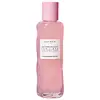What's inside
What's inside
 Key Ingredients
Key Ingredients

 Benefits
Benefits

 Concerns
Concerns

 Ingredients Side-by-side
Ingredients Side-by-side

Water
Skin ConditioningAlcohol Denat.
AntimicrobialPropanediol
SolventMandelic Acid
AntimicrobialGlycolic Acid
BufferingSalicylic Acid
MaskingLactic Acid
BufferingTartaric Acid
BufferingPyruvic Acid
MaskingCharcoal Powder
AbrasiveEucalyptus Globulus Leaf Powder
AbrasiveEucalyptus Globulus Leaf
Skin ConditioningHamamelis Virginiana Extract
AntiseborrhoeicAlgae Extract
EmollientSalix Alba Bark Extract
AstringentNylon-12
Aloe Barbadensis Leaf Juice
Skin ConditioningMentha Piperita Oil
MaskingSodium Hydroxide
BufferingCitric Acid
BufferingParfum
MaskingLimonene
PerfumingLinalool
PerfumingDisodium EDTA
Phenoxyethanol
PreservativeMica
Cosmetic ColorantCI 77891
Cosmetic ColorantCI 77499
Cosmetic ColorantWater, Alcohol Denat., Propanediol, Mandelic Acid, Glycolic Acid, Salicylic Acid, Lactic Acid, Tartaric Acid, Pyruvic Acid, Charcoal Powder, Eucalyptus Globulus Leaf Powder, Eucalyptus Globulus Leaf, Hamamelis Virginiana Extract, Algae Extract, Salix Alba Bark Extract, Nylon-12, Aloe Barbadensis Leaf Juice, Mentha Piperita Oil, Sodium Hydroxide, Citric Acid, Parfum, Limonene, Linalool, Disodium EDTA, Phenoxyethanol, Mica, CI 77891, CI 77499
Opuntia Ficus-Indica Extract
Skin ConditioningCitrullus Lanatus Fruit Extract
Skin ConditioningGlycerin
HumectantHyaluronic Acid
HumectantGluconolactone
Skin ConditioningSodium Polyglutamate
HumectantBetaine Salicylate
AntimicrobialSalix Alba Bark Extract
AstringentMelaleuca Alternifolia Leaf Extract
PerfumingHibiscus Sabdariffa Flower Extract
Skin ConditioningLactobacillus/Watermelon Fruit Ferment Extract
Skin ConditioningCucumis Sativus Fruit Extract
EmollientSaccharum Officinarum Extract
MoisturisingGlycyrrhiza Glabra Root Extract
BleachingScutellaria Baicalensis Root Extract
AstringentPaeonia Suffruticosa Root Extract
Skin ProtectingBrassica Oleracea Capitata Leaf Extract
Skin ConditioningIpomoea Batatas Root Extract
Skin ConditioningSorbitan Oleate
EmulsifyingLevulinic Acid
PerfumingSodium Levulinate
Skin ConditioningParfum
MaskingOpuntia Ficus-Indica Extract, Citrullus Lanatus Fruit Extract, Glycerin, Hyaluronic Acid, Gluconolactone, Sodium Polyglutamate, Betaine Salicylate, Salix Alba Bark Extract, Melaleuca Alternifolia Leaf Extract, Hibiscus Sabdariffa Flower Extract, Lactobacillus/Watermelon Fruit Ferment Extract, Cucumis Sativus Fruit Extract, Saccharum Officinarum Extract, Glycyrrhiza Glabra Root Extract, Scutellaria Baicalensis Root Extract, Paeonia Suffruticosa Root Extract, Brassica Oleracea Capitata Leaf Extract, Ipomoea Batatas Root Extract, Sorbitan Oleate, Levulinic Acid, Sodium Levulinate, Parfum
 Reviews
Reviews

Ingredients Explained
These ingredients are found in both products.
Ingredients higher up in an ingredient list are typically present in a larger amount.
Parfum is a catch-all term for an ingredient or more that is used to give a scent to products.
Also called "fragrance", this ingredient can be a blend of hundreds of chemicals or plant oils. This means every product with "fragrance" or "parfum" in the ingredients list is a different mixture.
For instance, Habanolide is a proprietary trade name for a specific aroma chemical. When used as a fragrance ingredient in cosmetics, most aroma chemicals fall under the broad labeling category of “FRAGRANCE” or “PARFUM” according to EU and US regulations.
The term 'parfum' or 'fragrance' is not regulated in many countries. In many cases, it is up to the brand to define this term.
For instance, many brands choose to label themselves as "fragrance-free" because they are not using synthetic fragrances. However, their products may still contain ingredients such as essential oils that are considered a fragrance by INCI standards.
One example is Calendula flower extract. Calendula is an essential oil that still imparts a scent or 'fragrance'.
Depending on the blend, the ingredients in the mixture can cause allergies and sensitivities on the skin. Some ingredients that are known EU allergens include linalool and citronellol.
Parfum can also be used to mask or cover an unpleasant scent.
The bottom line is: not all fragrances/parfum/ingredients are created equally. If you are worried about fragrances, we recommend taking a closer look at an ingredient. And of course, we always recommend speaking with a professional.
Learn more about ParfumSalix Alba Bark Extract comes from the white willow tree, which is native to Europe and Central Asia.
Salix Alba Bark Extract has often been described as salicylic acid's cousin. This is due to the salicin it contains. However, studies are limited showing salix alba bark to be an effective salicylic acid alternative.
Salicin does have anti-inflammatory and antioxidant properties. It has shown to decrease the formation of inflammatory mediators, such as tumor necrosis factor-α and nuclear factor-kappa B. Salicin also has a mildly exfoliating effect on the skin.
Several other components in salix alba bark extract also contain antioxidant properties, such as flavonoids and polyphenols. Antioxidants may help with anti-aging as they neutralize harmful free-radical molecules.
Willow Bark extract has been used for thousands of years. Ancient civilizations used white willow to help treat pain and fevers.
Learn more about Salix Alba Bark Extract